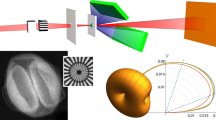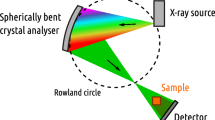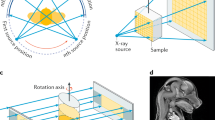Abstract
IMAGING with hard X-rays is an important diagnostic tool in medicine, biology and materials science. Contact radiography and tomography using hard X-rays provide information on internal structures that cannot be obtained using other non-destructive methods. The image contrast results from variations in the X-ray absorption arising from density differences and variations in composition and thickness of the object. But although X-rays penetrate deeply into carbon-based compounds, such as soft biological tissue, polymers and carbon-fibre composites, there is little absorption and therefore poor image contrast. Here we describe a method for enhancing the contrast in hard X-ray images of weakly absorbing materials by resolving phase variations across the X-ray beam1–4. The phase gradients are detected using diffraction from perfect silicon crystals. The diffraction properties of the crystal determine the ultimate spatial resolution in the image; we can readily obtain a resolution of a fraction of a millimetre. Our method shows dramatic contrast enhancement for weakly absorbing biological and inorganic materials, compared with conventional radiography using the same X-ray energy. We present both bright-field and dark-field phase-contrast images, and show evidence of contrast reversal. The method should have the clinical advantage of good contrast for low absorbed X-ray dose.
This is a preview of subscription content, access via your institution
Access options
Subscribe to this journal
Receive 51 print issues and online access
$199.00 per year
only $3.90 per issue
Buy this article
- Purchase on SpringerLink
- Instant access to full article PDF
Prices may be subject to local taxes which are calculated during checkout
Similar content being viewed by others
References
Somenkov, V. A., Tkalich, A. K. & Shil'shtein, S. Sh. Sov. Phys. Tech. Phys. 36, 1309–1311 (1991).
Mitrofanov, N. et al. Soviet Patent No. 1402871 (1986).
Belyaevskaya, E. A., Epfanov, V. P. & Ingal, V. Soviet Patent No. 4934958 (1991); US Patent No. 5319694 (1992).
Wilkins, S. W., Australian Patent Applic. PM0583/93 (1993) & PCT/AU94/00480 (1994).
Zernike, F. Z. Tech. Phys. 16, 454–457 (1935).
Steel, W. H. Interferometory 2nd edn (Cambridge Univ. Press, 1983).
Born, M. & Wolf, E. Principles of Optics 2nd edn (Pergamon, Oxford, 1964).
Hart, M. Rep. Prog. Phys. 34, 435–490 (1971).
Tanner, B. K. & Bowen, D. K. J. Cryst. Growth 126, 1–18 (1993).
Nakayama, K., Hashizume, H., Miyoshi, A., Kikuta, S. & Kohra, K. Z. Naturf. 28A, 632–638 (1973).
Matsushita, T. & Hashizume, H. in Handbook on Synchrotron Radiation Vol. 1 (ed. Koch, E. E.) Ch. 4 (North-Holland, Amsterdam, 1983).
Wilkins, S. W. Proc. R. Soc. 364, 569–589 (1978).
Azároff, L. V. et al. X-Ray Diffraction 180–191 (McGraw-Hill, Sydney, 1974).
Davis, T. J. Acta Cryst. A50, 686–690 (1994).
Authier, A. & Simon, D. Acta Cryst. A24, 517–526 (1968).
Uragami, T. J. phys. Soc. Japan 27, 147–154 (1969).
Afanas'ev, A. M. & Kohn, V. G. Acta Cryst. A27, 421–430 (1971).
Bonse, U. & Hart, M. Appl. Phys. Lett. 6, 155–156 (1965).
Wilkins, S. W. Australian Patent Applic. PM1519/93 (1993) & PCT/AU94/00480 (1994).
Author information
Authors and Affiliations
Rights and permissions
About this article
Cite this article
Davis, T., Gao, D., Gureyev, T. et al. Phase-contrast imaging of weakly absorbing materials using hard X-rays. Nature 373, 595–598 (1995). https://doi.org/10.1038/373595a0
Received:
Accepted:
Issue Date:
DOI: https://doi.org/10.1038/373595a0
This article is cited by
-
Parabolic gratings enhance the X-ray sensitivity of Talbot interferograms
Scientific Reports (2023)
-
On the quantification of sample microstructure using single-exposure x-ray dark-field imaging via a single-grid setup
Scientific Reports (2023)
-
The effect of a variable focal spot size on the contrast channels retrieved in edge-illumination X-ray phase contrast imaging
Scientific Reports (2022)
-
Crystal optics simulations for delineation of the three-dimensional cellular nuclear distribution using analyzer-based refraction-contrast computed tomography
Scientific Reports (2022)
-
Enhanced detection of threat materials by dark-field x-ray imaging combined with deep neural networks
Nature Communications (2022)




